IN THIS ISSUE
- New wild animal rules
- Right whales' dire state
- Trees to build around
- Coosa mussels on video
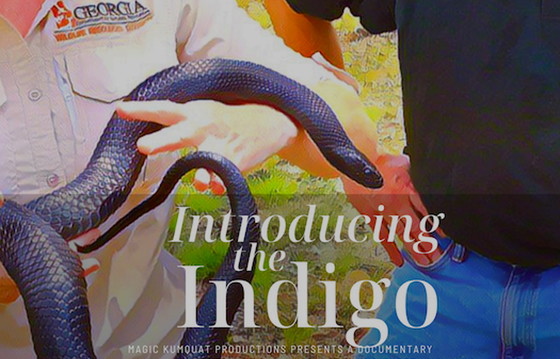 Coming soon to a PC near you: an educational video about eastern indigo snakes.
Geared to fourth- through eighth-graders, "Introducing the Indigo" played at the Wildlife Arts Festival in Thomasville and is part of the New York-based Wildlife Conservation Film Festival, which runs through Dec. 20 (tickets offer access to 100-plus films and interviews). The video will be rolled out to the public in January.
The federally threatened indigo, North America’s longest snake, is a key species in imperiled longleaf pine habitats. The indigo education campaign is led by The Longleaf Alliance, prescribed fire mascot Burner Bob and DNR. Laura Albritton directed the video. Zickie Allgrove filmed and DNR’s Shan Cammack produced it. The Environmental Resources Network and Ellen Jacobs provided funding.
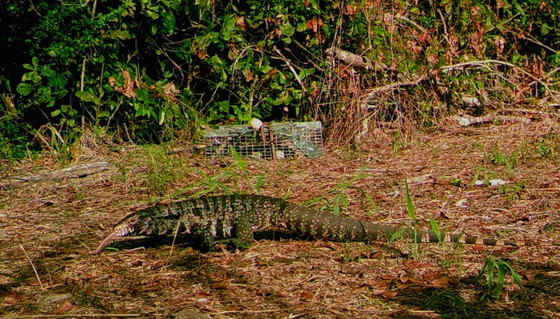 Camera-trap photo of a tegu in Tattnall County (USGS)
With Georgia wildlife facing increasing threats from non-native species, DNR is adding limits on what animals can be bought, sold or kept in the state.
Owners of these newly listed “wild animal” species, which vary from Argentine black and white tegus to giant African land snails, have a year to meet most of the requirements. This allows time for pet owners to register and tag six of the reptile species added, businesses to sell animals acquired before the changes and people ineligible for a permit or license to find their animals an appropriate home.
However, importing and breeding species added to the state’s wild animal list are prohibited starting Dec. 4, when the rules approved by the state Board of Natural Resources kick in.
Listed species are legally referred to as wild animals. The changes to the list, the first since 1994, include animals that pose a threat to wildlife or people. The revisions also update scientific names for some species.
Biologists decided which animals to add by reviewing non-native species documented in Georgia and nearby states and scientific publications assessing the ecological risks and any inherent danger to humans.
LEARN MORE
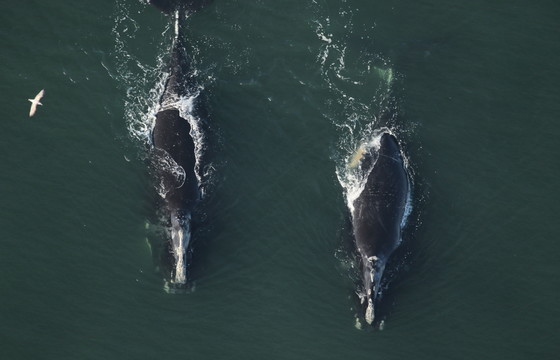 Females Smoke and Caterpillar off Virginia Nov. 22 (Clearwater Marine Aquarium, USACE/NOAA permit 20556-01)
Survey flights to document North Atlantic right whales began in mid-November along coastal North and South Carolina, signaling the start of calving season for one of the world’s most imperiled whales.
Yet the hope each sighting brings this winter will be dampened by new studies detailing the dire state of these bus-sized mammals that migrate south to the waters off Georgia and north Florida, the species’ only known calving ground.
First came a population estimate of only 340 whales in 2021, 10 fewer than 2020. Next followed news of modeling that shows a decline in breeding females from 2014-2018. Researchers say there are only about 72 left and fewer females are transitioning from pre-breeders to mothers.
The findings underscore the fact that right whales “can’t calve their way out of this problem.” said Clay George, a senior wildlife biologist who leads DNR's marine mammal work.
“The whales need a good calving year, but more importantly we need to stop human mortality” from commercial fishing gear entanglement and vessel strikes.
DNR is renewing efforts to inform recreational boaters about the risk that hitting a right whale poses to whales and boats. Three calves have died from collisions with boats less than 65 feet long since 2020.
Meanwhile, NOAA’s proposal to limit speeds on the East Coast for vessels 35-64 feet long – the threshold is now 65 feet – have raised questions and opposition. So have new regulations for lobster and Jonah crab trap and pot fisheries in the Northeast.
This isn’t the first brush with extinction for North Atlantic right whales. When commercial hunting was banned in the 1930s, there were as few as 100 left. But the low number of breeding females coupled with a shrinking population doesn’t bode well.
George and his team are preparing for the calving season – and searching for silver linings. He said research shows the number of pre-breeding females holding steady at about 70 whales. “If some of those females start having calves, it could really help.”
Another bright spot: No right whale carcasses were spotted in New England or Canada last spring or summer, a first since 2013. "A lot’s being done to increase protections and awareness in the U.S. and Canada,” George said. “Hopefully, we’re starting to see the fruits of those efforts.”
 Flashback to 2015: Smoke swims off Cumberland Island with her third known calf. (DNR/NOAA permit 15488)
WHAT YOU CAN DO
- When boating off Georgia's coast from November to April, follow the guidelines for navigating in right whale waters. Also, here’s a flyer listing recommendations for recreational boaters.
- Slow down when boating in right whale habitat (waters within 30 miles of shore). Use the Whale Alert app to see if whales have been sighted in the area.
- Report sightings by calling 877-WHALE-HELP (877-942-5343) or hailing the Coast Guard on marine channel 16.
- If you spot a whale, come to a stop, assess the area and slowly leave while keeping watch – other whales could be nearby.
- Stay at least 500 yards from any right whale seen (it’s the law) and never pursue or follow one.
- Be wise stewards of Georgia's natural resources and enjoy the outdoors responsibly.
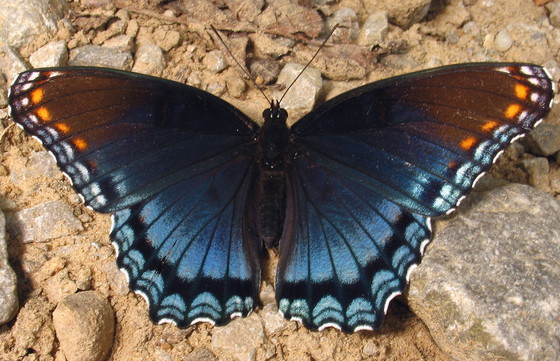 A red-spotted purple butterfly, one of the many butterflies and moths that use oaks as host plants (Alan Cressler)
By TERRY W. JOHNSON
Georgia’s population growth has brought about dramatic changes in the landscape. But while growth is inevitable, if we aren’t careful we risk destroying one of the reasons so many people want to move here – the natural beauty and wildlife that make Georgia such a special place to call home.
One way we can mitigate the impact is by preserving some of the native trees that are valuable to us and wildlife.
Planning on building a house? Before the bulldozer arrives, walk your property and mark the native trees that would add to the beauty of your new home while also providing your wildlife neighbors with food, nesting sites and protection from predators and the elements.
Here’s a short list of some of the trees to look for …
Read the rest of Terry’s column for more, including why these trees are valued.
Terry W. Johnson is a retired DNR manager and executive director of TERN, friends group of the Wildlife Conservation Section. Check out past columns and his blog. Permission is required to reprint a column.
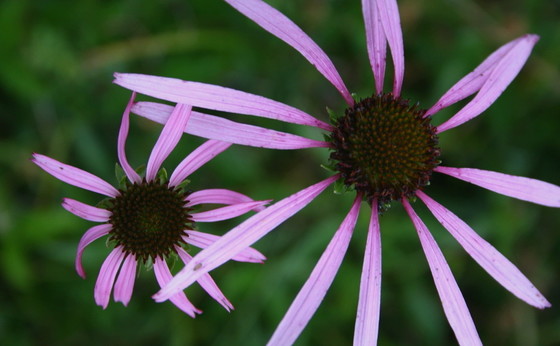 Smooth coneflower in Stephens County (Dale Suiter/USFWS)
After a quarter-century of work, smooth coneflower has reached a recovery milestone: a downlisting from endangered to threatened under the federal Endangered Species Act. Although conservation partners weren’t sure at first they would succeed, “We were determined to make as much of a difference as we could,” said Lisa Kruse, senior botanist with the DNR’s Wildlife Conservation Section. “The downlisting signals that coneflower is recovering in the landscape.”
With Recovering America's Wildlife Act awaiting a Senate vote, supporters are pressing for passage of the federal bill considered critical to saving the one-third of U.S. wildlife species at risk of becoming threatened or endangered. Powered by bipartisan support, the legislation passed the House and is favored by more than 70 percent of Americans, with fewer than 5 percent opposing. On the radio: National Wildlife Federation CEO Collin O'Mara discusses Recovering America's Wildlife.
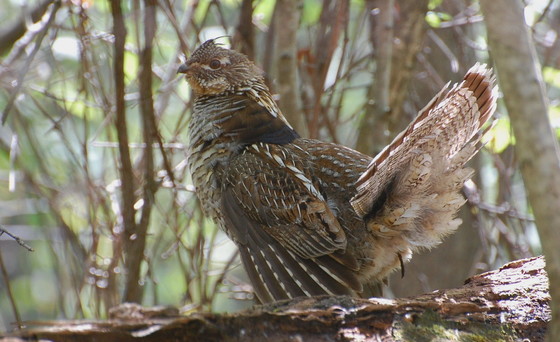 Public help wanted for UGA study of state's ruffed grouse (Adobe Stock)
When in the north Georgia mountains, keeping an eye and ear out for ruffed grouse can benefit UGA research examining grouse genetics to help stem the state’s declining population. Those not hunting grouse can provide “drumming” log locations, fecal samples from those sites and road-killed grouse. Details.
America the Beautiful Challenge grants announced by the National Fish and Wildlife Foundation include three projects involving Georgia. The Georgia Forestry Commission will receive about $1 million for prescribed fire and other work conserving longleaf pine habitat in the Georgia Sentinel Landscape, Austin Peay State University $495,000 to create a conservation plan for Cumberland Plateau grasslands, and the Appalachian Trail Conservancy $516,000 to remove invasive plants and protect ash trees on national forest lands in the trail’s corridor.
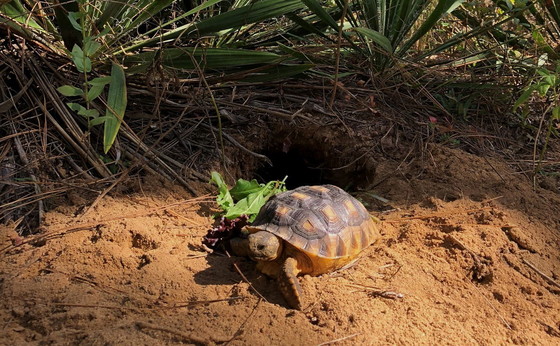 Juvie gopher tortoise and a starter home at Lanahassee Creek (Jessica Radich/USFWS)
The number of gopher tortoises at Lanahassee Creek Wildlife Management Area continues to grow, thanks in part to head-started tortoises added to the west Georgia WMA (also see: July 2019 issue). A release in October included 20 juveniles raised from eggs at Warm Springs National Fish Hatchery.
More than 70 women took a deep dive into everything from safely shooting firearms to processing deer during the annual Becoming an Outdoors-Woman workshop. The event at DNR’s Charlie Elliott Wildlife Center near Mansfield even raised $3,200 for a scholarship to help others attend the popular workshops.
Wildlife tales are the topic of the 33rd annual Give Wildlife a Chance Poster Contest. Sponsored by DNR, the State Botanical Garden of Georgia and The Environmental Resources Network, the K-5 competition aims to increase awareness and appreciation of Georgia’s biological diversity. Also open: 25th Fish Art Contest.
 Heads-up: Apply now for DNR's 2023 Career Academy.
Quick hits:
- Nov. 30 is the last day to apply for DNR’s 2023 Career Academy, set for July 16-22 and open to ninth-11th graders.
- Northern long-eared bats, a species documented in north Georgia and decimated by white-nose syndrome, will be reclassified from threatened to endangered, the U.S. Fish and Wildlife Service announced this week.
- A young bar-tailed godwit appears to have set a non-stop record for migratory birds, flying at least 8,435 miles from Alaska to Australia in 11 days.
- With changes varying from increased camping options to more visitors per day, a new visitor-use management plan for Cumberland Island National Seashore is available for public comment until Dec. 30.
- Keep track of the Georgia Aquatic Connectivity Team through the group's new social media accounts, including Facebook and Instagram.
Names in the news: Educator, artist and birder Lydia Thompson of St. Simons Island died Nov. 7. Plans are in the works for a bird walk to celebrate her life. The Congressional Sportsmen’s Foundation named Bass Pro Shops Founder and CEO Johnny Morris an Honorary Life Director, marking his contributions to conservation, hunting and fishing, and support for the foundation. The lifelong interest in wildlife of Larry Carlile, Fish and Wildlife Branch chief at Fort Stewart-Hunter Army Airfield, is profiled in this article. The fascination of DNR’s Dr. Brett Albanese with fish is obvious in the bluehead chub mask he wore on Halloween and in his latest rap video. (By the way, the Hershey's kisses represent tubercles and small stones are what bluehead chubs build nests with.)
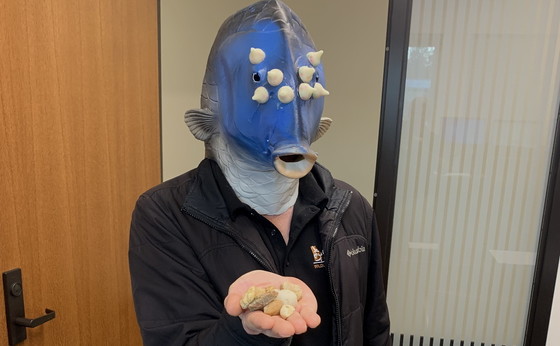 DNR's Brett Albanese models his blue chub mask and props.
"Georgia phasing in rules banning some wild animals as pets," Atlanta Journal-Constitution. Also: Yahoo!News (from Marietta Daily Journal), WSB-TV (ch. 2, Atlanta), (Thomasville) Times-Georgian, GPB, The Current and others.
"Experts work to prevent spread of avian flu," Savannah Morning News
"Flight team tracks right whales on East Coast," WTVT-TV (ch. 13, Tampa, Fla.)
(+audio) "Right whale population falls again, drawing closer to extinction," NPR
"Whole Foods decision to pull lobster divides enviros, pols," Associated Press
"Path to recovery clearer for smooth coneflower," Albany Herald
(+video) "Georgia wildlife enthusiast catches rare pine snake," Fox News
"Birdwatching has big mental-health benefits," Time
"U.S. agency sued over hands-off Okefenokee mine decision," Associated Press
(+video) "Feral pigs are going hog wild across Georgia," WSB-TV (ch. 2, Atlanta)
"Be on the lookout for invasive toxic toad," The (Vidalia) Advance
"Government social media to be thankful for" (includes DNR), Government Technology
"Indiana man receives lifetime hunting ban for poaching," Indianapolis Star
"Scientists ID new species of owl with insect-like cry," The Washington Post
 "Conserving Coosa Mussels," by Guy Eroh, working with DNR and others via UGA's River Basin Center
"Ask a Biologist: Herpetologist Daniel Sollenberger," DNR
"River Otters or Loch Ness Monster?" DNR (provided by Doug Still)
"Trail Cam Films Bear Squeezing from Crawl Space," Storyful Viral
All-terrain Action Trackchairs at work, DNR
"Creepy Critters Screams" (red fox), DNR
Biologists dive the Flint River to survey striped bass, DNR
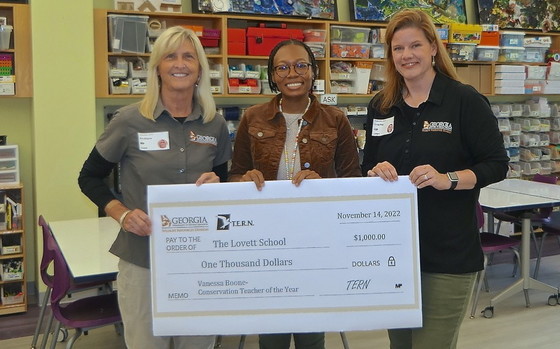 Vanessa Boone, center, a technology teacher at The Lovett School in Fulton County, received DNR’s Conservation Teacher of the Year grant from agency representatives Kim Kilgore, left, and Linda May. The $1,000 award goes to a third- through fifth-grade public or private school teacher in Georgia who demonstrates exceptional energy and innovation in teaching life sciences. May, outreach coordinator for the DNR Wildlife Conservation Section, said Boone’s proposal to design and build birdhouses featured “solid learning objectives, cross-curricular creativity and hands-on STEM activities.” The Environmental Resources Network, the Wildlife Conservation Section’s friends group, funds the grant.
CREDIT
Masthead: eastern indigo snake (Matthew Moore/DNR)
Top
|